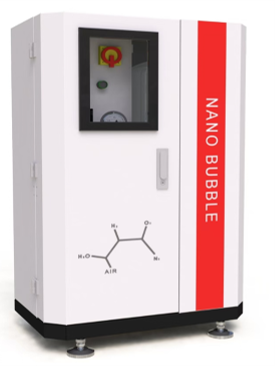Revolutionizing Dairy Processing with Nanobubble Technology
7/12/20254 min read


Understanding Nanobubble Technology
Nanobubble technology represents a significant advancement in various fields, including dairy processing. Nanobubbles are defined as gas bubbles with diameters ranging from 1 to 100 nanometers. This size sets them apart from microbubbles, which are larger and typically range from 1 to 100 micrometers. The distinguishing characteristics of nanobubbles include their remarkable stability, extensive surface area, and their unique ability to remain suspended in liquid for prolonged periods, making them exceptionally useful in applications requiring high levels of dispersion.
One of the key properties of nanobubbles is their incredible stability, which arises from the laws of physics governing small structures. Unlike larger bubbles, which tend to rise to the surface quickly and burst, nanobubbles resist coalescence, thus maintaining their form over an extended duration. This stability is critical in dairy processing as it promotes better gas solubility and can enhance various processes such as fermentation and purification. Furthermore, the large surface area of nanobubbles ensures effective interaction with the liquid medium, facilitating enhanced chemical reactions and mass transfer rates.
The generation of nanobubble technology typically involves several methods, including hydrodynamic cavitation or electrolysis, which introduces gas into a liquid under controlled conditions. This process produces an abundance of nanobubbles, which can be generated using various gases, such as air, oxygen, and carbon dioxide. Particularly notable is the environmentally friendly nature of utilizing air or other sustainable gases to create nanobubbles, reducing reliance on chemical additives in dairy processing.
Overall, the integration of nanobubble technology into dairy processing holds the potential to revolutionize the industry by enhancing efficiency, promoting sustainability, and improving product quality. By harnessing the unique properties of nanobubbles, dairy producers can ensure better outcomes in their operations while maintaining an eco-friendly approach.
Application of Nanobubbles in Dairy Processing
Nanobubble technology has emerged as a transformative force in the dairy industry, significantly enhancing the processing capabilities and overall product quality of dairy streams. One key application of nanobubbles is in the improvement of viscosity and solubility in milk protein concentrates and concentrated milk. By introducing nanobubbles into these dairy streams, producers can reduce viscosity levels. This makes the processing of dairy products more efficient, allowing for easier pumping, mixing, and transportation of the materials. Additionally, the increased solubility offered by nanobubbles contributes to a more uniform and consistent product, essential for meeting consumer expectations.
Moreover, the impact of nanobubbles extends to the nucleation and crystallization processes. In traditional dairy processing, controlling these processes can be challenging. However, the presence of nanobubbles provides nucleation sites, facilitating the formation of crystal structures within the dairy products. This leads to better emulsification and stabilization, which are crucial for products like cheese and yogurt. Enhanced control over crystallization not only improves the textural qualities of these products but also helps in extending their shelf life, a considerable advantage for manufacturers.
The advantages of integrating nanobubble technology do not stop at production efficiency; they also have implications for product quality. Dairy products treated with nanobubbles exhibit superior sensory attributes, including improved flavor and mouthfeel. Additionally, the reduction of viscosity and enhancement of solubility can lead to products that are more appealing to consumers, thus increasing market competitiveness. As dairy manufacturers continue to explore innovative solutions, the application of nanobubbles presents a promising avenue for achieving higher quality products while optimizing processing conditions.
Reduction of Fouling in Membrane Filtration
Fouling in membrane filtration is a significant challenge faced in dairy processing, often resulting in decreased efficiency and increased operational costs. This phenomenon occurs when undesirable substances adhere to the membrane surface, leading to permeate flux decline and the need for frequent cleaning. The introduction of nanobubble technology presents a promising solution to minimize fouling and enhance the performance of membrane systems in dairy applications.
Nanobubbles are ultrafine bubbles, typically measuring less than 200 nanometers in diameter, which possess unique properties that allow them to interact with foulants in a beneficial manner. When injected into the filtration system, these nanobubbles attach to particles and large molecules present in the dairy fluid. This enables the agglomeration of foulants, subsequently facilitating their detachment from the membrane surface. Furthermore, nanobubbles improve fluid dynamics by creating micro-jets during bubble collapse, which can dislodge fouling layers and maintain cleaner membranes.
Incorporating nanobubble technology into the filtration process not only reduces the frequency of membrane cleaning but also enhances the overall lifespan of the membranes themselves. Cleaner membranes mean more efficient processing as the permeability remains high, reducing energy consumption and operational costs associated with downtime and maintenance. Recent studies have shown that using nanobubbles can lead to significant reductions in fouling rates, resulting in 30-50% longer operational periods between cleanings.
Moreover, case studies in various dairy processing facilities have demonstrated the effectiveness of this technology. Facilities that adopted nanobubble systems reported substantial improvements in permeate quality and increased yields, further solidifying the role of nanobubbles as an innovative approach to optimizing membrane filtration in dairy processing. Embracing this cutting-edge technology provides a pathway toward revolutionized and sustainable dairy operations.
Enhancing Antimicrobial Efficacy with Nanobubbles
Nanobubble technology has emerged as a transformative approach in dairy processing, particularly in enhancing the efficacy of antimicrobial agents. These extremely small bubbles, measuring between 100 nanometers and 200 nanometers, possess unique properties that facilitate better distribution and absorption of antimicrobial compounds. Unlike traditional bubbles, which can rapidly coalesce and rise to the surface, nanobubbles remain stable in liquids, allowing for prolonged interaction with antimicrobial agents and pathogens alike.
The small size and large surface area of nanobubbles contribute to their exceptional ability to transport and enhance the effectiveness of antimicrobials. As these bubbles disperse within liquid dairy products, they create a microenvironment that increases the bioavailability of antimicrobial agents. This enhanced distribution ensures that the active components are delivered uniformly throughout the product, maximizing their potential to combat harmful bacteria and other pathogens that can compromise food safety.
Furthermore, nanobubbles can aid in reducing the overall concentration of antimicrobials needed for effective pathogen control. By improving the penetration of these agents into microbial cell walls, nanobubble technology may lower the volume of chemicals required, subsequently minimizing potential negative impacts on flavor and quality. This reduction not only addresses consumer concerns regarding chemical residues but also promotes sustainability within dairy processing operations.
As the dairy industry continues to prioritize food safety and shelf-life extension, incorporating nanobubble technology could represent a pivotal advancement. The efficacy of antimicrobial solutions is paramount in preventing spoilage, reducing foodborne illnesses, and enhancing the overall quality of dairy products. Ultimately, the application of nanobubbles offers a promising route toward safer, more reliable dairy processing practices, highlighting their role as a critical innovation in food technology.
Innovation By Research
Shenton Way, Singapore
© 2024. C2C Technology Singapore Pte Ltd All rights reserved.
Company
RELATED Products
INDUSTRY NEWS
